VIRGINIA GORDON
Communications Coordinator
Metro Parks is fortunate enough to own and operate one of the most-admired public gardens in the entire Midwest. Inniswood Metro Gardens is now a 123-acre botanical garden and nature preserve in Westerville, Ohio. It boasts 10 feature gardens, more than 2,000 species of plants, and is surrounded by woodlands awash with wildflowers and wildlife. Yet, had it not been for the foresight of sisters, Grace and Mary Innis, this wonderful public facility would not exist.
THE INNIS SISTERS
The sisters acquired a 38-acre slice of land, then known as Brookwood, in 1960, and commissioned a local architect, Tom Tully, to design and build a home for them on their new Westerville estate. Now known as Innis House, the sisters moved in to their new home in August 1961. Grace had a particular love of horticulture, and especially enjoyed collecting, growing and showing peonies, daylilies, iris, daffodils and hosta. A graduate of Ohio Wesleyan University in 1916, Grace furthered her education by studying art and horticulture at The Ohio State University. She quickly developed new cultivated gardens on the estate. Mary, her younger sister by 11 months, was also a graduate of Ohio Wesleyan University. She loved the deep woods on their new estate and found them a wonderful natural resource for birdwatching and spotting wildlife.
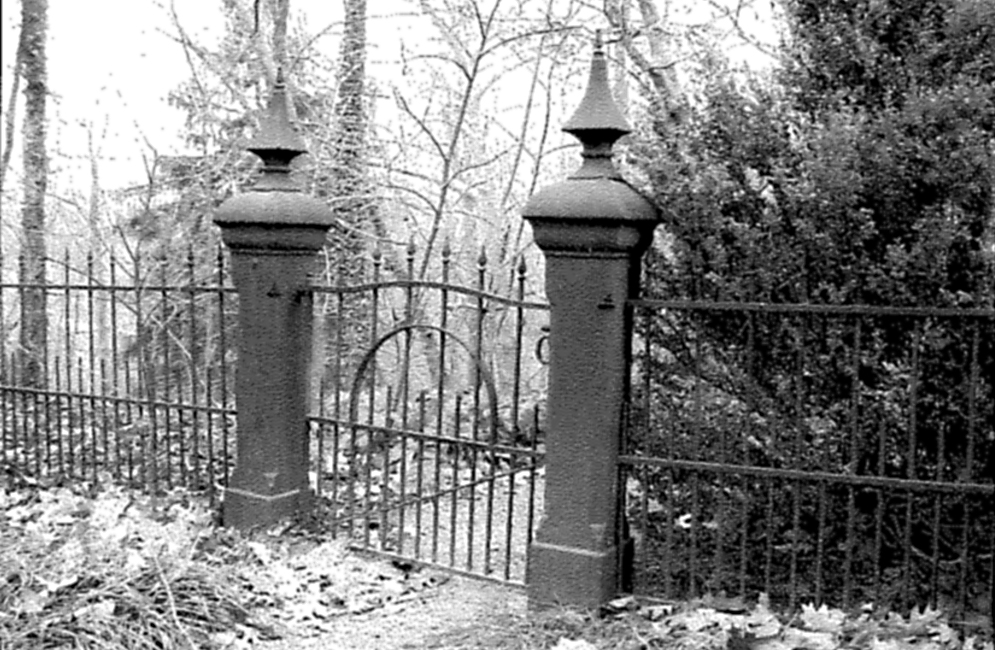
The sisters had grown up on a 1,000-acre family farm on Cleveland Avenue in Linden Heights, where they also indulged their passions for horticulture and wildlife study. When they moved to Brookwood, they brought with them numerous mementos of their old house. These mementos include a gate from the iron fence that surrounded their gardens at Cleveland Avenue. The gate can be seen in Inniswood’s Memorial Garden and it has become a logo for two of Inniswood’s supporting organizations, the Inniswood Volunteers Inc and the Inniswood Garden Society.
The sisters had been in their new home for only five years when, sadly, younger sister Mary passed away. She was aged 70. Two years later, in 1968, Grace first mooted the idea of donating the sisters’ property to Metro Parks. The sisters had been in agreement that they wished their property to be preserved as gardens and woodlands for the enjoyment of the public, and that it should be endowed with a foundation to provide for the maintenance of the area. Grace’s proposal envisaged her living out her life on the estate, which would be maintained by Metro Parks as a public garden after she died.
THE INNISWOOD RESOLUTION
The Metro Parks board was very receptive to this wonderful offer. Wheels can turn slowly across the legal terrain of property rights, but eventually an agreement was enshrined in a Metro Parks Board Resolution. A copy of the board resolution, honoring the Innis sisters and accepting Grace’s offer, was presented to Grace at her home in May 1972.
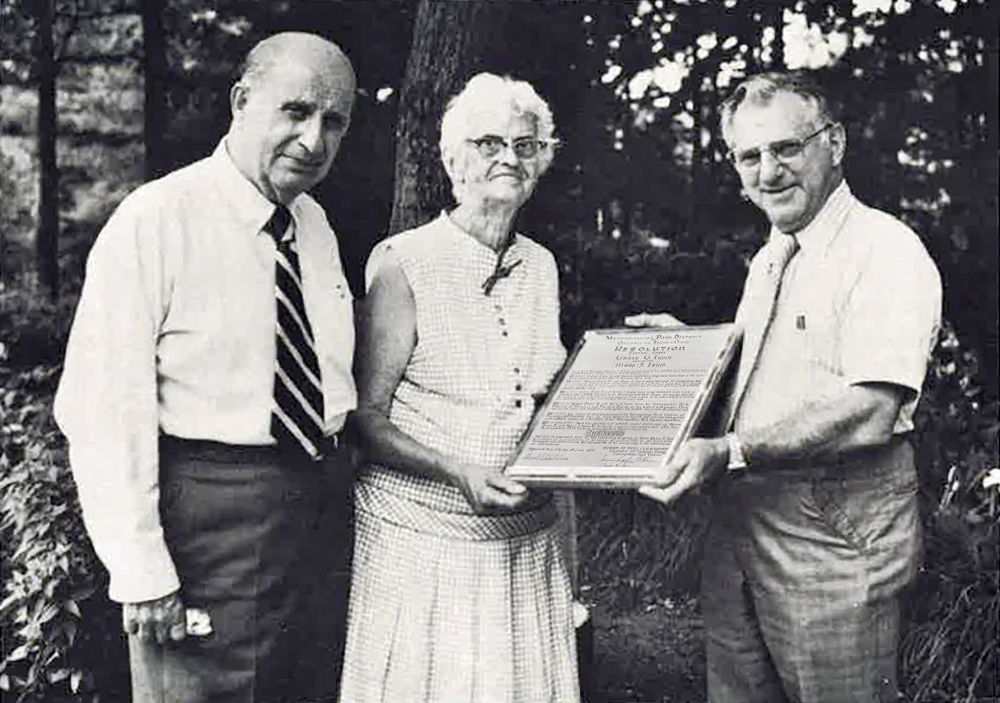
As declared in the Resolution: Be it resolved that the garden and wildlife center envisioned by Misses Grace G. and Mary J. Innis be formally accepted and established with the Metropolitan Park System, to be known forever more as INNISWOOD, and that an engrossed copy of this resolution be given to Miss Grace G. Innis to evidence the appreciation of the people of central Ohio for the Innis sisters foresight and dedication to the cultural life of the community in the establishment of INNISWOOD.
As per the agreement, Metro Parks acquired an additional 54 acres of adjacent land, to be a buffer against property development and to enhance the future gardens and woodlands. This additional land was acquired with the assistance of the Ohio Department of Natural Resources and the US Department of the Interior’s Bureau of Outdoor Recreation. The Inniswood Foundation, within the Columbus Foundation, was established to provide for the future maintenance of the area. But Metro Parks understood there would be a need for a huge input of capital improvement funds to properly develop the area in the future.
PUBLIC CONSULTATION
Initially conceived as the Inniswood Garden Center, Metro Parks created an advisory council, made up of planning staff and numerous community gardeners and gardening clubs to develop a master plan for the future gardens. In 1977, a figure of $1,402,000 was established as needed for the development of Inniswood over the coming 12 years of the Metro Parks’ long-term capital improvement plan. This figure, informed by the master plan, envisaged the creation of an entrance road and parking lots, a garden auditorium and library, various formal and informal gardens (with the hope that local plant societies would choose to maintain specialist gardens at Inniswood for the testing and display of new plant varieties), greenhouses for displays and plant propagation, and a nature trail system for wildflower programs and nature walks in the woods. It was hoped that the development of Inniswood would be further supported by community groups and citizens through gifts, bequests and memberships.
A 30-acre portion of the Innis estate was formally deeded to Metro Parks in March 1978. Grace continued to maintain her gardens on the remaining 7 acres of her estate, and lived happily in her home until sadly, she passed away in March 1982, aged 88.
At public meetings in late 1982, gardening clubs and societies, plus many interested community gardeners, came together for discussions about the need for volunteers and funding before the proposed Inniswood Metro Gardens could formally open to the public. It led to the creation of the Inniswood Volunteers Inc, a nonprofit corporation with IRS tax exemption, governed by elected officers. The first training class of the Inniswood Volunteers was held in 1983, one year before Inniswood Metro Gardens would open its gates to visitors.
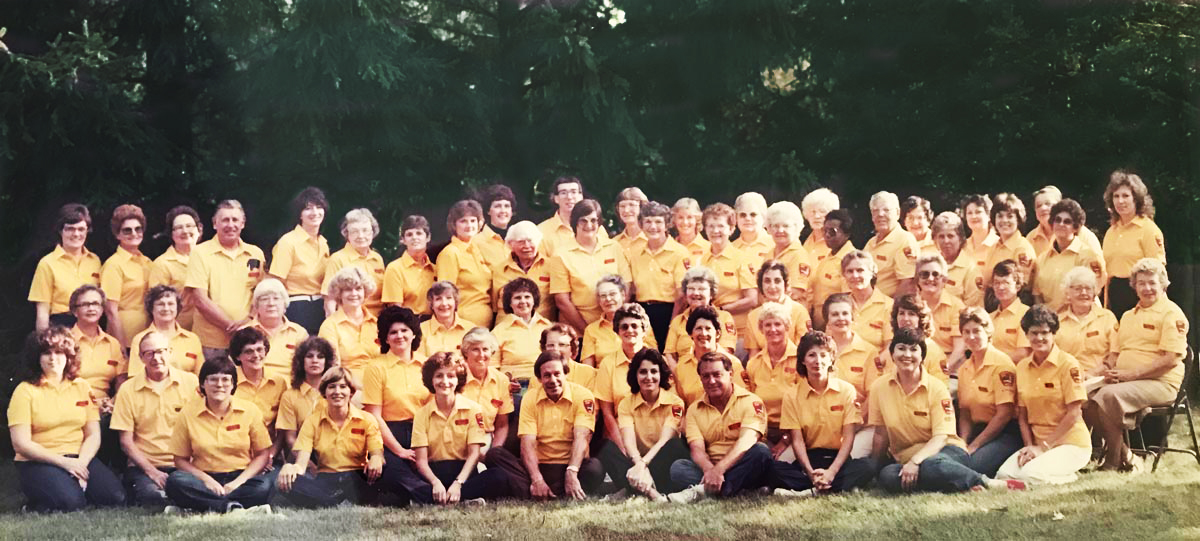
Today, Inniswood Volunteers Inc is over 300 members strong, giving hundreds of hours of service each month. They are crucial to Inniswood’s operations and success. Volunteers work on garden beds, planting or weeding; they design and create the annual container gardens (more than 80 containers per year, with a different theme each year), are the most enthusiastic cheerleaders for the gardens, and help with many of Inniswood’s educational programs and school group visits. (For more information about volunteer service at Inniswood call the Inniswood Volunteer Coordinator on 614-895-6226.)
A membership organization, The Inniswood Garden Society (IGS), was created in 1984 to assist Metro Parks in the growth and development of the gardens. The Society has played a vital role in the development of the gardens, as you’ll discover later in the article. For more information about The Inniswood Garden Society and the benefits of becoming a member, check out their website HERE.
Inniswood Metro Gardens opened in 1984 and became the eighth Columbus and Franklin County Metro Park. At the time, the gardens extended over an area of a little more than 92 acres. Another 31 acres were added to the gardens in March 2000, south of the parking lot, bringing the size up to its current 123 acres.
The sisters’ house was formally named Innis House and became the office setting for the public gardens manager and staff, and also hosted a non-lending horticulture library and a large multipurpose room, both open to the public. The multipurpose room can seat up to 100 people and is used by gardening clubs and horticultural organizations. It is also the site for public art exhibitions. The very popular Artist of the Month exhibitions feature works by local photographers and painters and have been a long-standing focus of interest for visitors. Education staff also use the multipurpose room as the base for some of their public programs. Inniswood offers between 20 and 30 public programs a month, for children or adults, on a variety of gardening and nature themes.
PARTNERSHIP GARDENS
As Inniswood Metro Gardens began to develop and expand its facilities, partnerships came to the fore. A first example of this was the creation of the Rose Garden, which opened with a dedication ceremony on September 15, 1985. The Rose Garden resulted from a partnership with the Central Ohio Rose Society and included a terrace, which was gifted to Metro Parks by Stella Milburn, a longtime friend of Grace Innis. The rose trellis was added in 1988, and was built with funds donated by Cardinal Industries. The Rose Garden features beds of floribunda, grandiflora and hybrid tea roses, and numerous climbing species. In 2025, thanks to funding from the Columbus Foundation, Metro Parks has tackled massive decay in the wood of the rose trellis, which has been rebuilt and repainted.
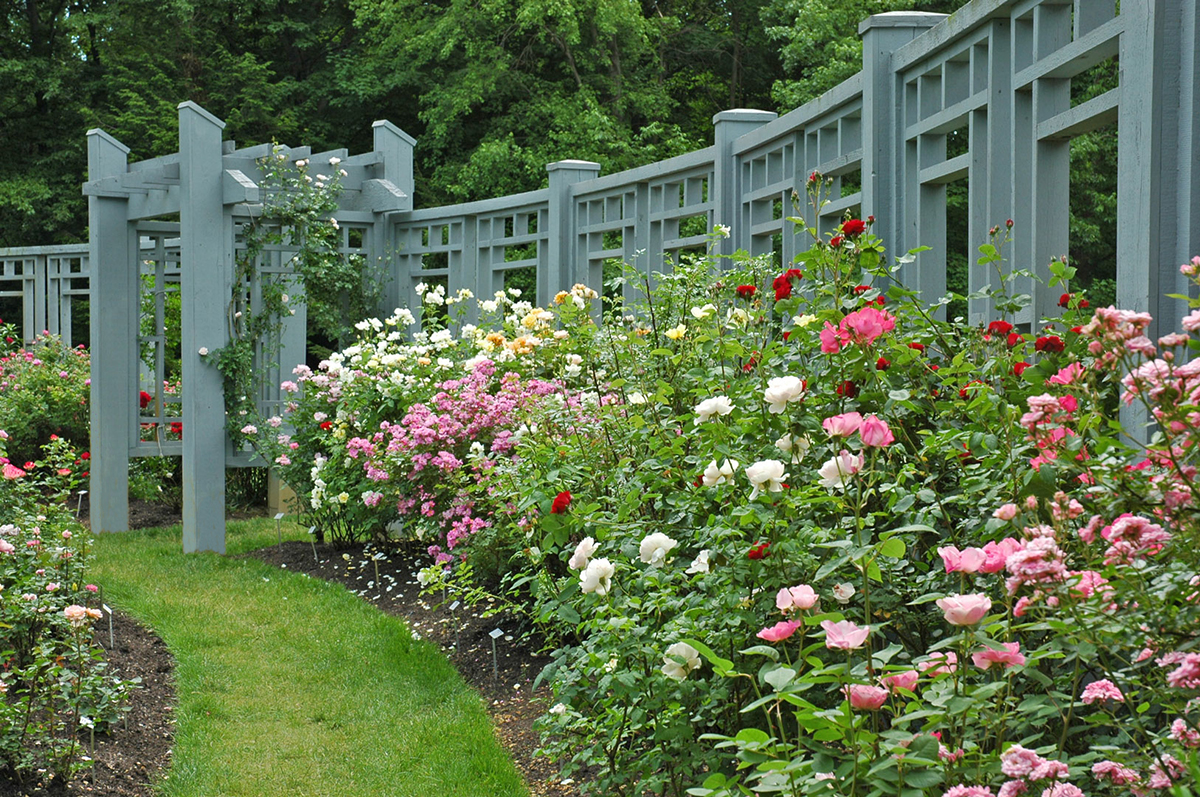
–
The Herb Garden also resulted from a partnership, this time with The Herb Society of America, Central Ohio Unit. It was opened in June 1988 and features a series of themed gardens. These include the Bee Garden, full of nectar-rich herbs to attract bees; the Bible Garden, made up of herbs mentioned in the scriptures; the Culinary Garden, with herbs used for seasoning in cuisine; the Fragrance Garden, scented with the aromas of lavender, wisteria and roses; the Gray Garden, featuring contrasting shades of gray foliage; the Knot Garden, which utilizes a formal design hugely admired in Europe during the 16th and 17th centuries; the Medicinal Garden, filled with plants used for healing; and lastly, and considered the jewel of the garden by the Herb Society itself, the Thyme Collection. A beautiful gazebo also stands in the Herb Garden and is a very popular stopping point for visitors.
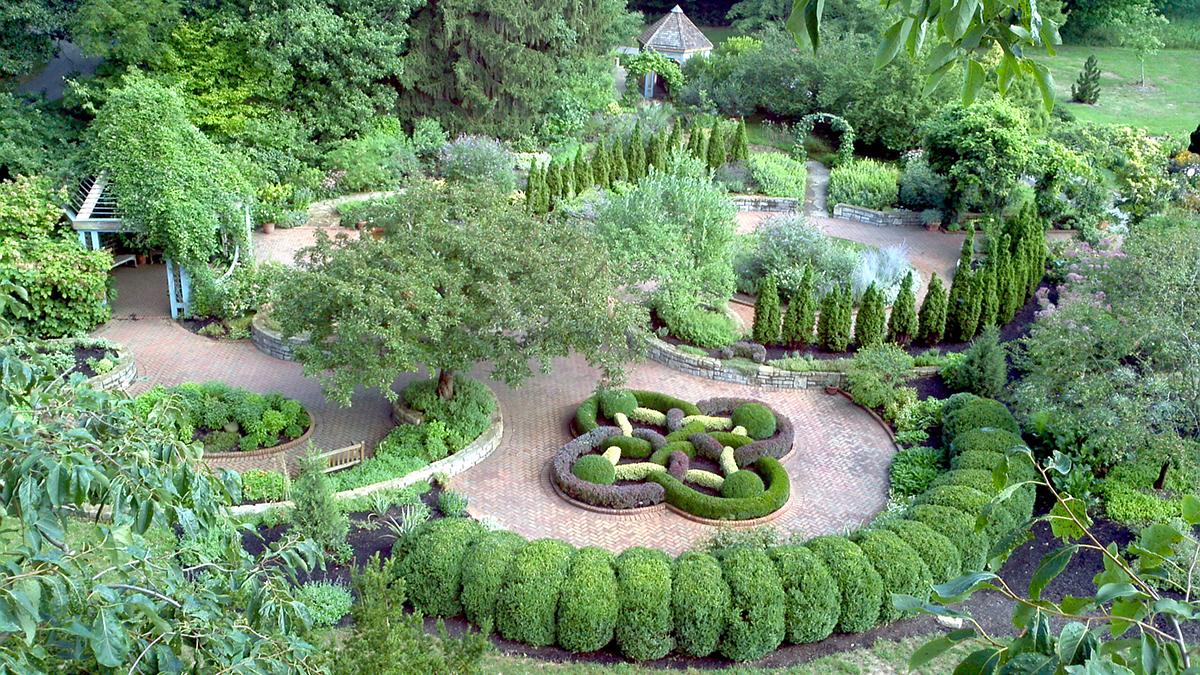
–
ROCK GARDEN
Grace Innis had utilized a natural ravine on her land to create a rock garden, but it was realized that the terrain could not support the huge visitor numbers coming to the new Metro Parks facility. In the first couple of years after opening, Inniswood Metro Gardens received more than 100,000 visitors per year. The Inniswood Volunteers were keen to preserve Grace’s intent and established a fund to support a future Woodland Rock Garden. One of the early contributors to the fund was the retailer, JC Penny.
With funding established, construction of the new Woodland Rock Garden began in October 1991. It was opened with a dedication ceremony on April 26, 1992. The new garden was able to utilize many of the plants used in Grace’s original rock garden. Because of the large number of trees in the immediate area, many shade-tolerant plants were added to the rock garden. The Rock Garden features a circulating system of three layered pools, connected by a stream. Always one of the most admired gardens by visitors and photographers, the Woodland Rock Garden benefited from significant restoration work in the 2010s, to maintain its beauty and stability for the vastly increasing number of visitors. For many years, annual visitor numbers have exceeded a quarter of a million as Inniswood Metro Gardens continues its mission to build upon the legacy of the Innis sisters.

–
DEER TROUBLE
In common with some other parks in the 1980s, Inniswood Metro Gardens suffered from the activities of a surfeit of deer. In certain years, the entire hosta and day lilly collections were completely destroyed by deer, and many other plant collections were seriously damaged. In an effort to rescue the gardens, a deer-proof fence was erected around the landscaped areas in 1993, with considerable success. Deer were confined to the woodland areas and the cultivated gardens thrived.
ROAD TROUBLE
The early 1990s presented Inniswood Metro Gardens with another threat, one that would imperil its hard-won status as a haven of beauty, peace and tranquility. The City of Westerville planned to extend Schrock Road through the northern edge of the gardens. The proposed 0.6-mile extension was claimed to be needed to cope with burgeoning traffic congestion in Westerville. A founding member of the Inniswood Volunteers, Janet Withers, became heavily involved with the public campaign to halt the road extension. “The gardens could have been ruined,” she stated, if that campaign had failed. The Inniswood Volunteers, gardeners, horticulture lovers, and masses of concerned citizens, voiced their objections stridently at public debates and via letters to newspaper and media editors. They argued that the serenity of the gardens would be permanently shattered by the extension, and that woodlands and wildlife would be severely harmed or destroyed. A public vote finally decided against the extension, with Westerville voters rejecting the city’s proposal in November 1994. Inniswood Metro Gardens was saved.
THE SISTERS’ GARDEN
The Inniswood Garden Society had played a key role in attracting donations for the restoration of the Woodland Rock Garden. It also played a pivotal role in the development and funding of The Sisters’ Garden. This major project had a slated opening date in 2002, to mark the 30th anniversary of the agreement made between Grace Innis and Metro Parks to develop Inniswood as a public facility.
Although conceived as a children’s garden, a broader theme emerged, and the aim and purpose of the The Sisters’ Garden arose: “To Nurture the Nature of the Child in Everyone.”
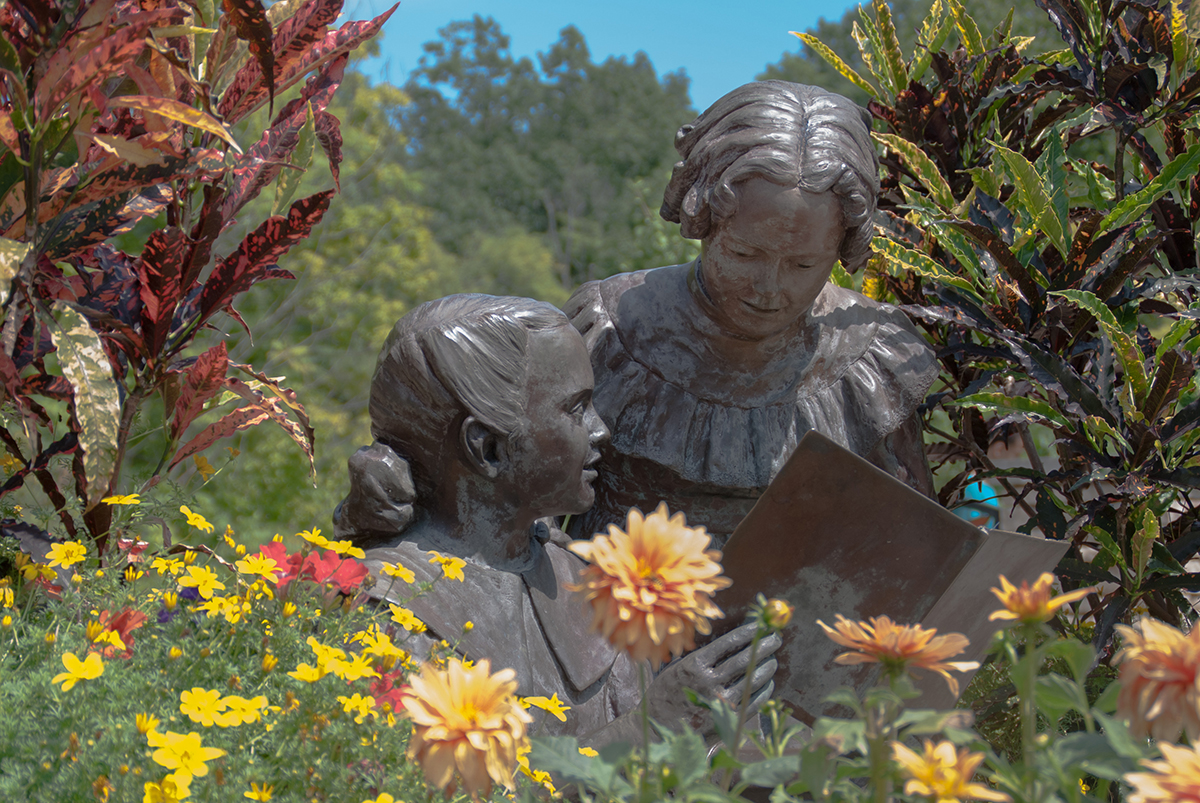
Building began in June 2000 and the garden was completed in time for its official dedication on June 12, 2002, exactly 30 years after the formal agreement that established Inniswood as a future public gardens. Set in a 2.8-acre area, The Sisters’ Garden would embrace several feature gardens and areas. Giant, brightly colored aluminum and resin sunflowers mark a dramatic opening to the Entry Garden, which features a bronze statue of Grace and Mary Innis as children. The Country Garden reflects the history of the Innis family farm on Cleveland Avenue, with a small-scale farmhouse and barn (named Granny’s House and Bessie’s Barn), offset by a tall-grass prairie and orchard, with a windmill and water tower, often used in educational programs.
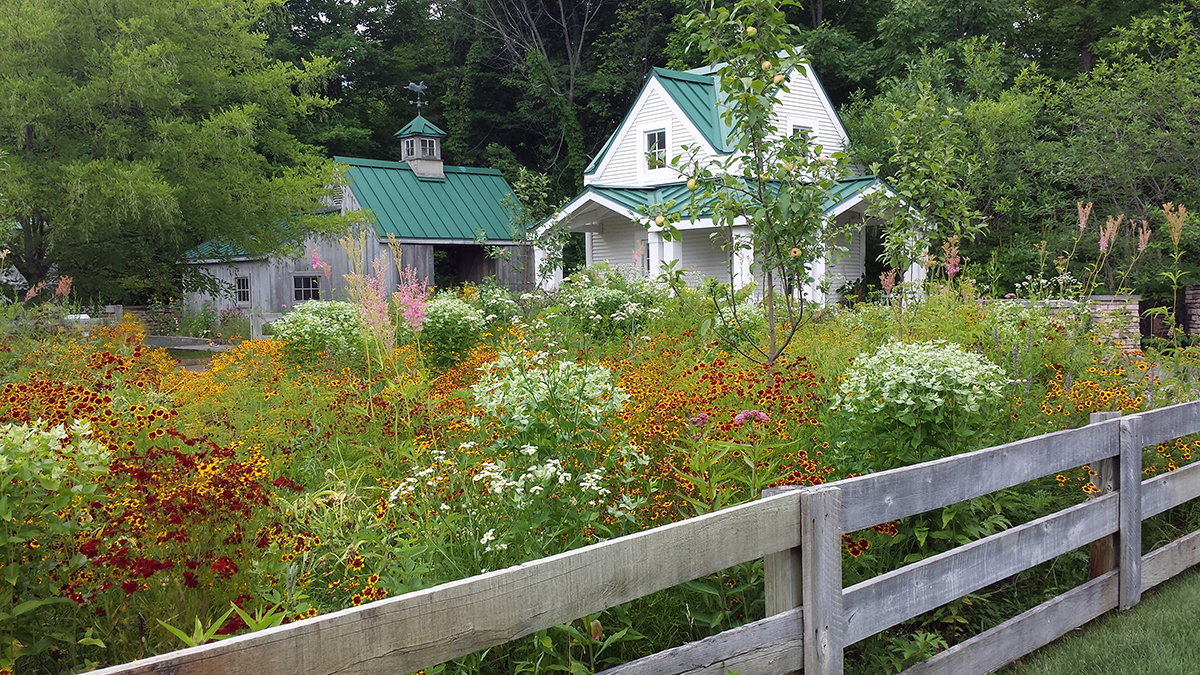
Other features include a Wetland Garden, with a pond, rocks and a trellis cave reflecting the Jackson Pike Sand and Gravel Company, partly founded by Grace and Mary’s father, Lewis Innis; a Woodland Garden that includes a treehouse area, rope bridge and hand-carved art pieces, a Secret Garden, with atmospheric ruins; and two maze gardens.
The Story Maze tells a Native American creation myth legend, Earth on Turtle’s Back. The story is carved into the maze’s paving stones. The path leads to the Circle Maze, where the legend is reflected visually by the 9-foot painted wooden statue of Sky Woman standing on Turtle’s Back.
EVENTS & ATTRACTIONS
Inniswood Metro Gardens had become a shining attraction for visitors from its earliest days. The balance of beautiful lawns, cultivated gardens, and trails through deep woodlands kept regular visitors returning. And big events helped generate new visitors.
For a 10-year-period, 1996 to 2005, Affair of the Hort was held on a fall weekend and generated spectacular attendance. Thousands of people came each year to enjoy this festival of horticulture, organized in partnership with the Herb Society of America, Central Ohio Unit. Affair of the Hort featured special displays, guest speakers, lecture sessions, garden vendors, a children’s activity tent, and lots of other entertainment.
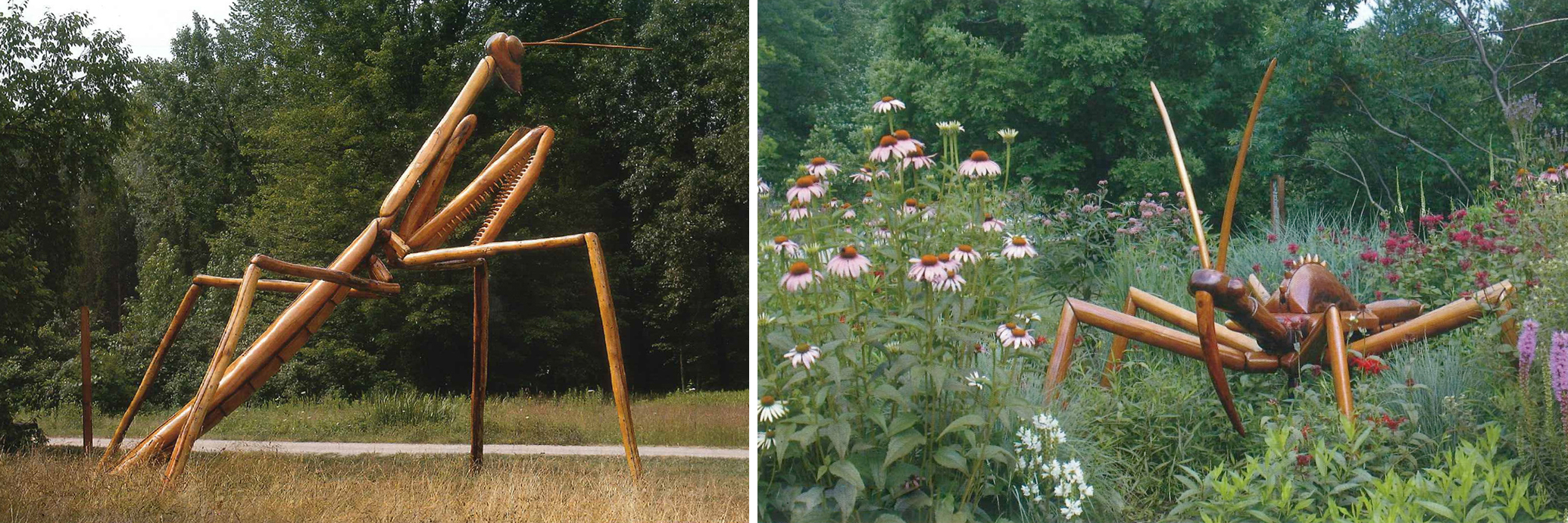
Even more people were drawn to the gardens for the Big Bugs exhibition of 2007. From mid-July to mid-October, the gardens were populated by 10 giant structures – insect sculptures by artist David Rogers. “Insects play this vital role in a garden but are unnoticed, so I put them on such a large scale that you can’t help but notice them,” Rogers said. His “insects” included three ants, their bodies made of willow and their eyes made of red cedar, and each of them 25 feet long and 4 feet wide. They weighed an incredible 725 pounds. The other massive insects comprised a dragonfly, damselfly, lady bug, assassin bug, grasshopper, spider in a web, and —most massive of all— a 1,200 pound praying mantis, 18 feet long and 20 feet wide. The praying mantis was made entirely of black locust. Special programs, events and entertainments were organized throughout the summer to supplement the exhibition. The Inniswood Garden Society was the presenting sponsor for the exhibition.
Other regular, crowd-pleasing events, include the annual weekend Plant Sale in spring and the summer Music in the Gardens series.
GARDEN IMPROVEMENTS
In 2009, an imposing wooden portal was built adjacent to the parking lot and this became the new formal entrance to the gardens. The entrance was flanked by an iron fence —an echo of the exterior boundary fence on Hempstead Road— and by 6,400 square feet of new garden plantings. One side of the fence was planted with Grace Innis legacy plants, to reflect Grace’s love of iris, daylilies, peonies and daffodils.
The Education Pavilion, another wooden structure, opened in 2010 and is used for programs such as Wellness in the Gardens and events such as the Music in the Gardens concerts. And in 2016, Inniswood opened its Greenhouse Multipurpose Center. The 2,880-square-foot building has become the base of operations for volunteer groups working in Inniswood, and owes its existence in large part to the generosity of longtime Inniswood Volunteer, Dottie Bevier. When Dottie passed away in 2014, she gifted a large sum of money to provide the start-up funds for the multiuse building. Additional fundraising for the $275,000 building was led by the Inniswood Garden Society. The new facility, with its extra space, has made garden operations much more efficient.
INNISWOOD TODAY
Now well established as a premier botanical garden and nature preserve, Inniswood Metro Gardens is visited by more than a quarter of a million people each year. It features 10 named gardens, each with a different character. In addition to the gardens already mentioned (The Rose Garden, the Herb Garden, the Woodland Rock Garden, and The Sisters’ Garden), Inniswood hosts the Brookwood Trail Garden, with seasonal displays and a vast hosta collection; the Circle Garden, the first garden you encounter after walking through the entrance portal, known for its beautiful spring tulips and other seasonal dispays; the Conifer Garden, funded by a private donation and the home for a collection of evergreens, including dwarf varieties; the Cutting Garden, featuring colorful beauties often used as cut flowers; the Fern Garden, used as a test site by the Hardy Fern Foundation; and the Memorial Garden, with island beds of shade-tolerant perennial and woody plants, and the site where the hosta “Inniswood” was discovered and where the original Innis sisters’ gate is located. In addition to the named gardens, Inniswood Volunteers design and created the annual Container Garden displays, made up of more than 80 containers. Inniswood horticulturists and volunteers came up with a new theme each year for the container gardens and for other seasonal display beds throughout the facility.
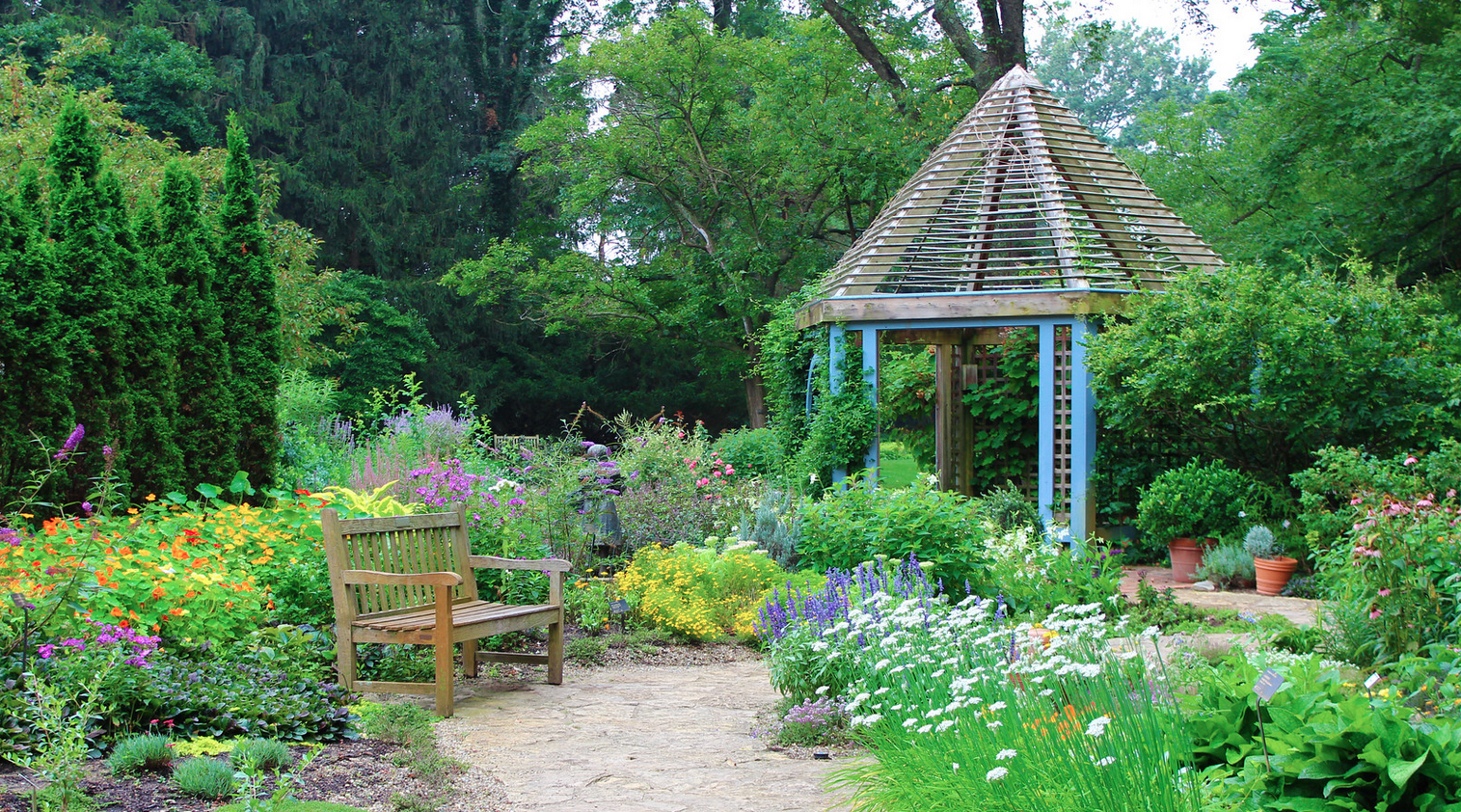
As well as the paths through the gardens, there are more than 2 miles of trails at Inniswood, including the 0.5-mile gravel and boardwalk Boardwalk Trail, which passes through the nature preserve, a beech-maple forest; the 0.5-mile Brookwood Trail; the 0.1-mile boardwalk, Frog Talk Walk; the 0.3-mile Sisters’ Garden Loop; and the 0.3-mile Spring Run Trail.
As befits a botanical garden, pets and active recreation are not permitted in the gardens or natural areas at Inniswood. Pets and biking are allowed on the parking lot, and on the Chipmunk Chatter Trail, a 0.6-mile paved trail on the outside of the gardens.
You can keep apprised of plants in bloom and events on the horizon by checking out the Inniswood Metro Gardens Facebook page

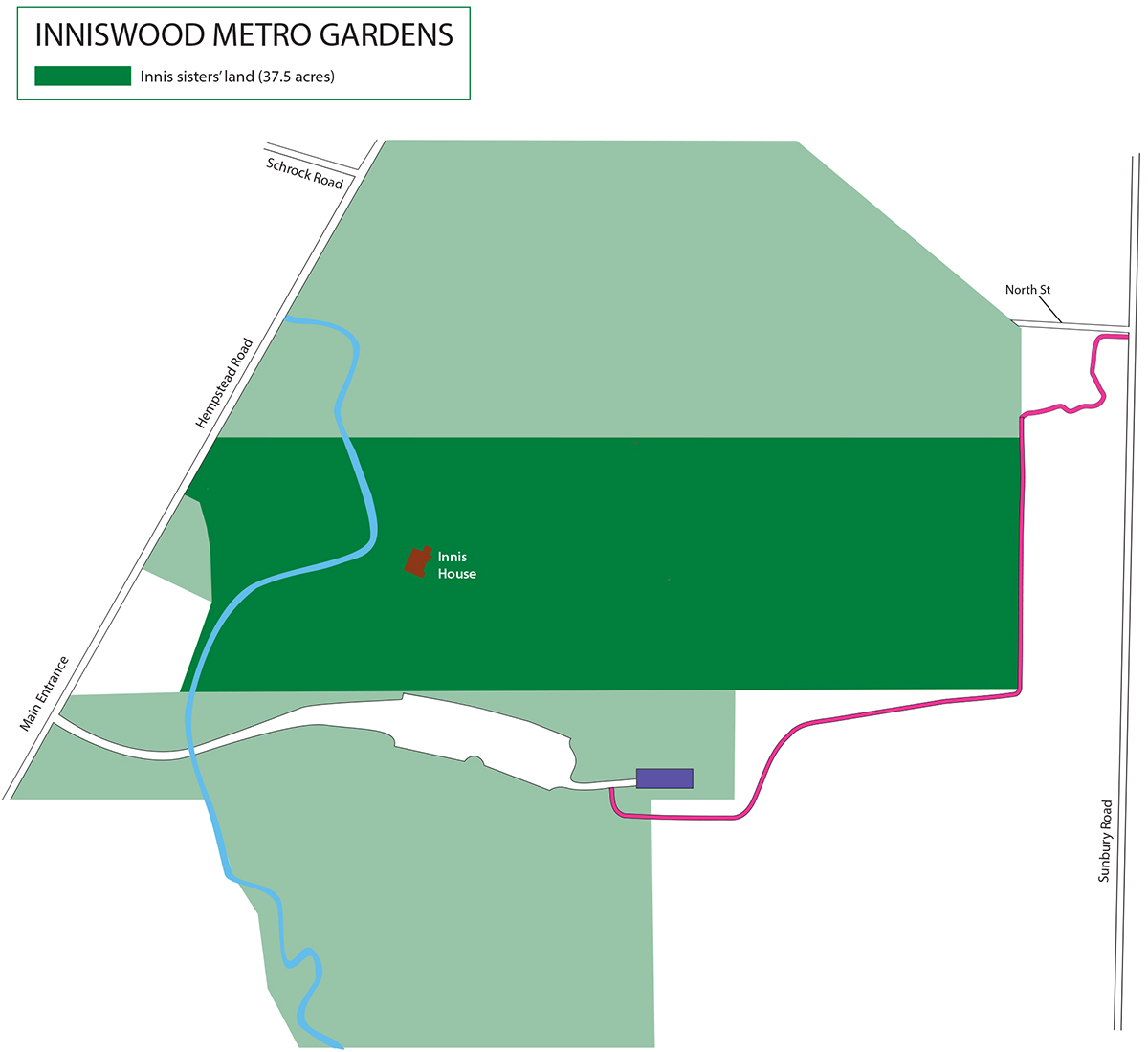
Very beautiful and attractive gardens. I have been there before and hope to come again…keep this coming.
My family moved to Columbus 21 years ago from central Illinois. We were sad that we would no longer be visiting the Missouri Botanical Garden on a regular basis–one of our very favorite weekend getaways. When we discovered the Metro Parks system we were thrilled! My husband and I have been in love with Inniswood since the first time we visited and it has remained our number one park for strolling and unwinding from the busyness of life. Thank you so much to ALL the Metro Parks staff members for the amazing job you do to make all the parks inviting places to get back in touch with nature and leave behind the noise and stress of our lives these days.
BEAUTIFUL PLACE!!!!!!
I visited 2 years ago. The house was closed due to Covid. But I did wander around the gardens. The place is amazing. I love flowers and trails to explore. I would highly recommend visiting here. I want to no back very soon. I took so many photos of the flowers and other things. I love the roses. Nature and flowers are in abundance here. Please visit. It is well worth it!
More Inniswood and Gosnell family history:
I purchased my home site (now considered an adjacent Inniswood inholding) along what was known as Hemstead Rd then. At that time there were only 4 houses within a mile, so this was open countryside, mostly forested, and Hemstead Rd dead ended at Dempsey and Walnut Roads, and there was not a north and south Hemstead Rd. Following the erection of my family home, 906 Hemstead Rd, Clyde Mann approached me with an offer to purchase the original 35 acres, now known as Inniswood, for $1,000. per acre. I reluctantly declined his offer as I had just purchase 35 acres further north on Hemstead Rd.
In retrospect, it was a historic decision; as my not making the purchase resulted with Grace and Mary Innis, soon thereafter, accepted the Clyde Mann offer – and of course the rest is history with a great result and ultimate service to the community with an environmental gem.
Grace and Mary soon became special friends and neighbors. I provided many voluntary services to the Sisters with gardening, providing and managing honeybees, as I am a 4th generation apiarist. Grace and Mary seemingly adopted my 3 children, Lisa, Brad, and Laurie. For several years my children worked diligently for the Sisters with much gardening management. Our family tradition continues, as my daughter Laurie, husband Jim, follow the family history of residing at 906 S. Hempstead Rd, and likely will continue with future generations.
Many great memories of friendship with Grace and Mary; one such occasion: Mary enjoy the Columbus Symphony, so my late wife, Sue, and I frequently took Mary to the Symphony; however, Mary often fell asleep during the performance and snored, so I would nudge her to her annoyance!
In later years, I was delighted to serve on the Inniswood Board, a special board, for the design and fund raising to erect the Sister’s Gardens to honor their memories and contributions to the community.
In year 2000, the community and family celebrated my 70th B-Day in Grace and Mary’s home – a surprise occasion that seemed like a final chapter in my special memories with our dear Sisters.
Note: In 1976 I chose to celebrate our national revolution, independence from Great Britian. I did so by planting 187 specimen trees in the Blendon Township community as ‘street landscaping’. Fred Milligan, Sr, attorney on Dempsey Rd, procured a grant to aid with funding our joint mission. There is a granite stone and bronze plaque commemorating the event, located in the Blendon Township Cemetery, near the Spring Rd west gate of the cemetery.
Many cheers to the special historic memories and dear friends that I cherish.
Clyde Gosnell, age 92.
Thank you, Clyde, for sharing your knowledge of the Innis sisters and your relationship with them.
Gorgeous in all seasons! Highly recommend visiting, it’s our favorite park.
In the late 1970’s I picked up Grace to take her to an Ohio Wesleyan alumna event. When we returned she asked me to brush away the February snow to see if the perennials by her driveway were emerging. They were. Grace was a lovely lady.